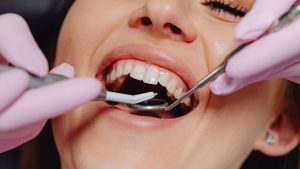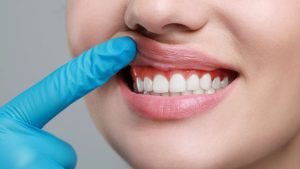It’s no secret that the best way to prevent oral decay and disease is by maintaining a strict oral hygiene routine every day. Brushing and flossing go hand in hand; you shouldn’t do one without the other. Brushing your teeth is an excellent way to remove food debris and flossing allows you to get into the hard to reach areas between your teeth that your toothbrush cannot reach. Both effectively remove plaque, which erode your tooth enamel if left untouched long enough. This then eventually leads to tooth decay. Plaque also causes gum disease and bad breath.
Brushing
- After choosing a toothbrush with a small head and soft bristles, grasp it with your fingers and apply a pea-sized amount of fluoride toothpaste on the bristles.
- Be sure to hold the bristles near the gum line.
- Sweep the brush gently back and forth over your teeth and gums in soft strokes or a circular motion, but do not apply too much force.
- Clean away food debris between your teeth and away from your gums by using a sweeping motion.
- Don’t forget to brush the back of your teeth as well, tilting the bristles up toward the gums for the top teeth or down toward the gums for your bottom teeth.
- Also brush the chewing surfaces of your teeth by holding the bristles flat against your molars to clean all the ridges of your back teeth.
- Repeat this whole process for your other row of teeth.
- Finally, carefully brush your tongue to remove extra bacteria.
Flossing
- Begin by cutting off a piece of floss about 18 inches long.
- Wind the floss around the middle finger of both your hands, leaving a gap between them that spans about three or four inches.
- It’s common for beginners to tighten their lips and cheeks, making it difficult to get their fingers into their mouth. Be sure to relax them.
- Slowly guide the floss between your teeth. If the gap is tight, use a gentle sawing motion to slip the floss between the gap. The sawing motion should only be used when slipping floss between your teeth.
- There are two sides to each space between your teeth. They must be flossed separately in order to not irritate the triangle of gum tissue between the teeth. Run the floss up and down the surface of the first side, making sure that you’re reaching the gum line and then to the highest point between the teeth. Apply pressure away from the gum triangle, letting it curve around the first side of the tooth to form a letter “C” with the floss. Repeat this process with the other side of the tooth.
- Work all around the mouth to get every side and the backsides of your molars.
- Feel free to unwind more floss if you find your strand fraying or turning brown.


